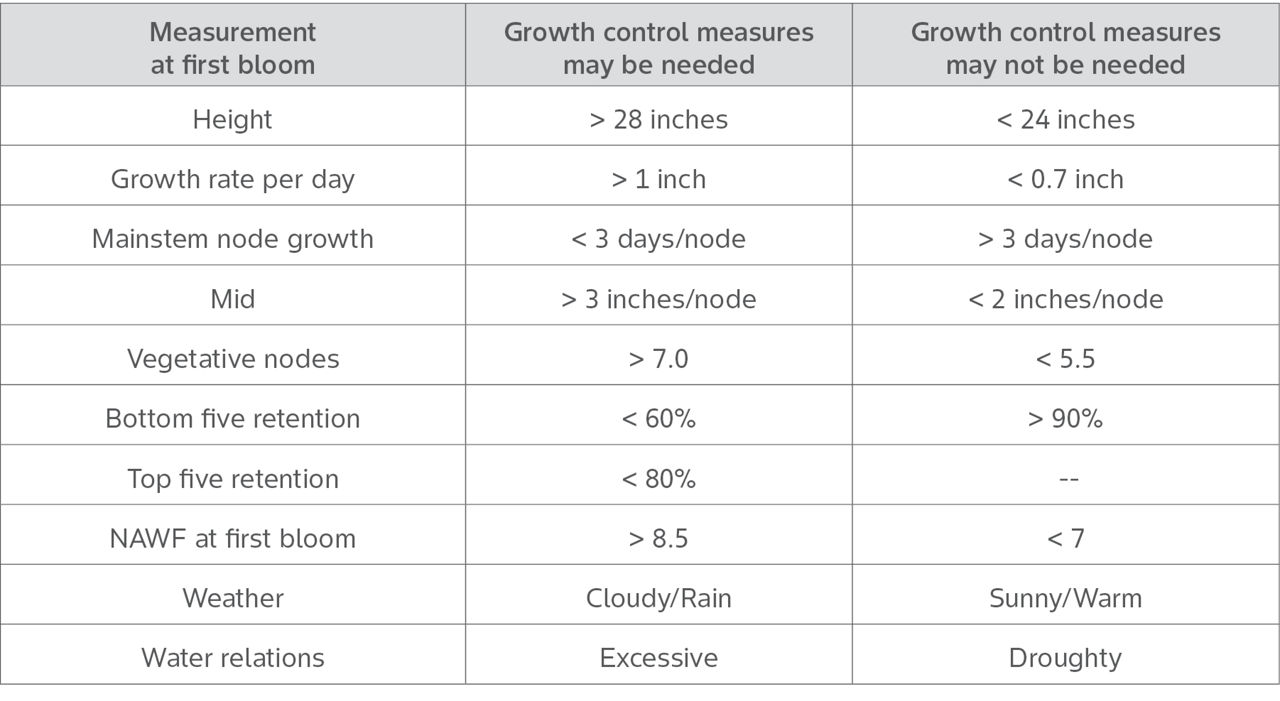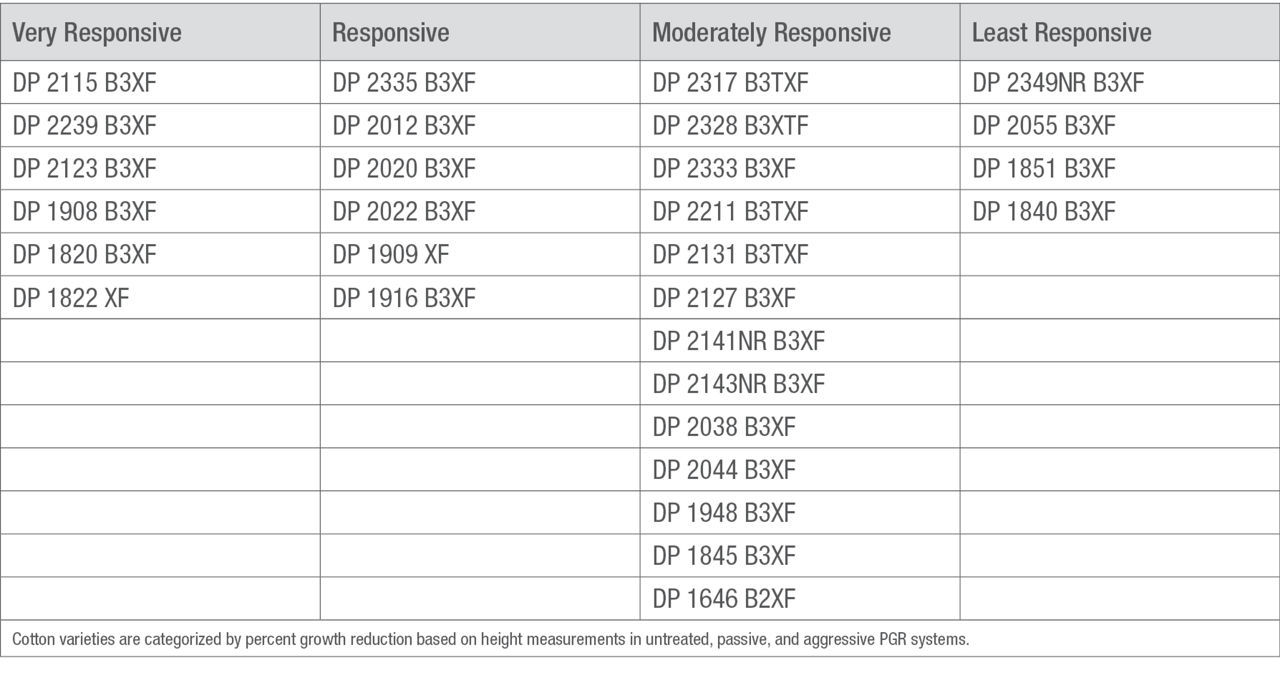7 MIN READ
Cotton Growth Management
March 26, 2024
- Closely monitoring cotton growth helps growers determine when to make a plant growth regulator (PGR) application, which can help increase cotton fiber quality and yield potential.
- Understanding the growth habit and PGR response of a cotton variety is important for developing a growth management strategy.
Cotton is a perennial plant with an indeterminate growth pattern and varying levels of indeterminacy that are independent of maturity group. Understanding the degree of indeterminacy of a cotton variety can help with seed placement and crop management. Varieties with a more indeterminate growth habit can sustain terminal growth longer than less indeterminate varieties. Although node counts may be similar prior to bloom, varieties with higher indeterminacy can continue to produce nodes while less indeterminate varieties shift toward cutout. More indeterminate cotton varieties can continue to develop nodes and fruit in stressed growing conditions, but maturity can be delayed for late-set bolls. Cotton specialists recommend monitoring cotton plant growth and applying plant growth regulators (PGRs) to help prevent excessive vegetative growth, especially for more indeterminate varieties.
Cotton Growth Monitoring
Several measurements can be used to help monitor cotton growth (Table 1). Using a combination of these measurements can provide a more accurate evaluation of crop growth. During bloom, plant height, mainstem node growth rate, nodes above white flower (NAWF) counts, square retention, and maximum internode distance should be recorded on a weekly basis.
Table 1. Recommendations for growth control according to cotton growth measurements at first bloom and field conditions.

Plant height. Mainstem height is one of the most common cotton measurements and is useful in making management decisions when combined with other information. Generally, at first bloom or shortly thereafter, cotton is growing at its maximum rate. A growth rate of about 1 inch per day is the upper limit of acceptable growth.
Mainstem nodes. Development of mainstem nodes is also close to its maximum rate near first bloom. A new mainstem node develops roughly every 2.5 to 3 days, or approximately every 40 to 50 DD60s. Water availability and carbohydrate production are the largest influencers of mainstem node development.
Squaring nodes. The maximum number of fruiting branches prior to bloom, or the maximum nodes above white flower (NAWF), is an excellent indication of vigor. Measurement of NAWF is effective because it directly corresponds to energy absorption by the reproductive and vegetative demands of the plant. This measurement monitors the difference between the rate at which squares reach bloom and the rate that new mainstem nodes are produced.
As NAWF declines, nodes are being produced slower than first fruiting position squares reach bloom. This value ranges from 5 to 10, with 8 and 10 nodes being most common if stress has not been a contributing factor. Values of 7 or less at first bloom indicate low vigor and that using a PGR is not recommended until the stress is alleviated. If the value is closer to 10 and/or does not decline at a rate of about 1 node per week, vigor is high and using a PGR may be beneficial. Five NAWF indicate the plant is entering cutout.
Maximum internode distance (MID). The distance between the 4th and 5th nodes from the terminal is the most sensitive measurement of vigor. It includes the effects that current inputs are having on growth and the relationship between carbohydrate supply and demand. If MID exceeds 3 inches, then current growth is vigorous and needs control. If MID is less than 2 inches, growth is limited and may need investigation. In some situations, cotton with a MID under 2 inches may be a normal response to boll retention, PGRs, and environmental conditions. Mepiquat chloride rate and timing sticks (Figure 1) are available to help provide recommendations according to the average internode length of the top 5 nodes of the plant. The longer the internode length, the higher the recommended rate.
Managing Growth with PGRs
Mepiquat chloride and mepiquat pentaborate both contain mepiquat, which is an anti-gibberellin growth retardant that reduces plant cell enlargement to help balance vegetative and reproductive growth. When applied to cotton, mepiquat can help control rank growth by reducing stem elongation at newly formed internodes. The application of PGRs can help increase fruit retention and promote earlier maturity, reducing the crop’s risk of late-season insect damage, boll rots, and harvest losses. Mepiquat applications have been linked to increased cotton yield potential when applied at the optimum rate and timing for the variety and field planted.
Understanding the growth habit of a cotton variety is important to manage vegetative growth. Certain varieties can have a more aggressive growth pattern, so PGR rates and timing must be managed accordingly. The projected response of Deltapine® brand cotton varieties to the application of mepiquat is provided in Table 2. Varieties that are most responsive may need lower rates or fewer applications of mepiquat, whereas varieties that are least responsive may require timely, early season applications at higher rates or multiple applications to control vegetative growth.
Table 2. Response of Deltapine® brand cotton varieties to growth management with mepiquat plant growth regulator.

*Mepiquat plant growth regulator response categorization based on preliminary data.
For cotton varieties in the moderately and least-responsive categories, growers should plan to apply mepiquat at 8 to 10 nodes (matchhead square) and aggressively apply mepiquat if there is a history of rank growth, if the crop received early rainfall, or if the cotton was planted behind a crop where a high nitrogen rate was applied. Mismanagement of PGRs can have a negative effect on yield potential, especially when they are applied too early or when the cotton plant is stressed, or when they are applied to a less indeterminant cotton variety.
In-season cotton plant monitoring provides the best information to determine application rate and timing of growth control measures. Every cotton field is under different conditions so growth management strategies should be tailored to each field situation.
Sources
1 Ritchie, G.L., Bednarz, C.W., Jost, J.H., and Brown, S.M. 2004. Cotton growth and development. University of Georgia Cooperative Extension, Bulletin 1252. https://hdl.handle.net/10724/12192
2 Edmisten, K. and Collins, G. 2024. Suggestions for growth regulator use. North Carolina State University Cooperative Extension Service. 2024 Cotton Information. https://content.ces.ncsu.edu/cotton-information/suggestions-for-growth-regulator-use/
3 Late planted cotton and plant growth regulators (PGR’s). 2019. The University of Georgia Cooperative Extension. https://site.extension.uga.edu/plowpoints/2019/07/late-planted-cotton-and-plant-growth-regulators-pgrs/
4 Oosterhuis, D. and Robertson, W. The use of plant growth regulators and other additives in cotton production. University of Arkansas. AAES Special Report 198. Proceeding of the 2000 Cotton Research Meeting. https://www.researchgate.net/publication/242152959_The_use_plant_growth_regulators_and_other_additives_in_cotton_production/
Web sources verified 02/26/24. 1414_75751
Seed Brands & Traits
Crop Protection
Disclaimer
Always read and follow pesticide label directions, insect resistance management requirements (where applicable), and grain marketing and all other stewardship practices.
©2024 Bayer Group. All rights reserved.